Injectable Drugs Market Size
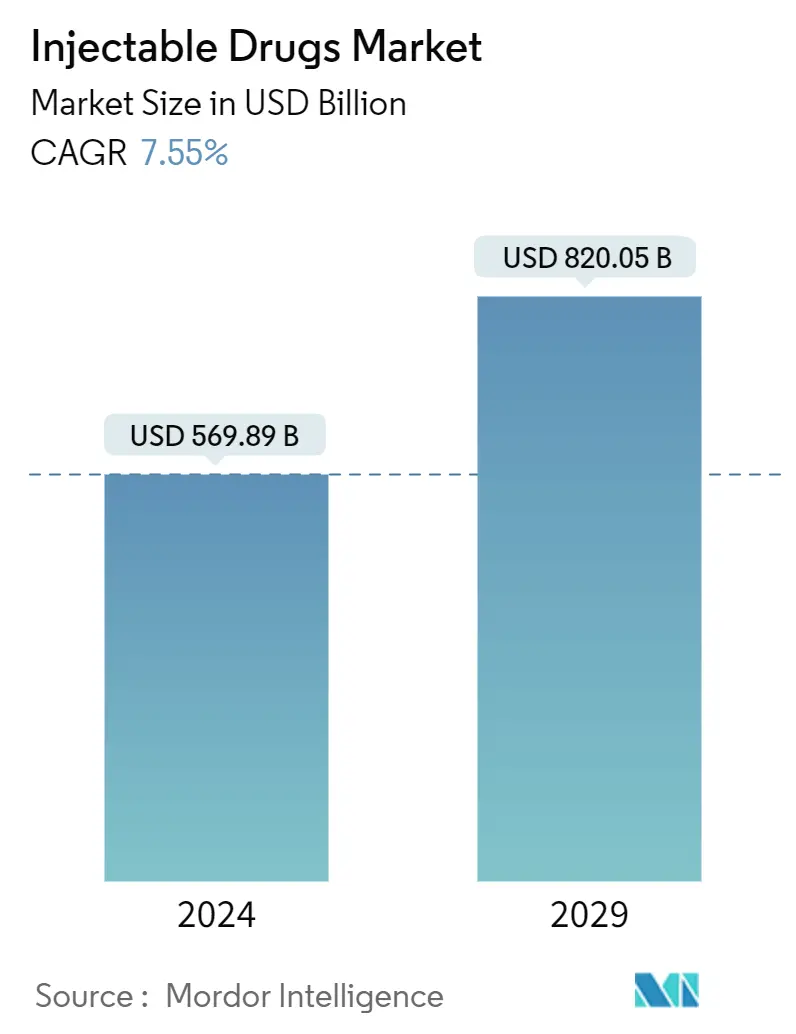
| Study Period | 2019 - 2029 |
| Market Size (2024) | USD 569.89 Billion |
| Market Size (2029) | USD 820.05 Billion |
| CAGR (2024 - 2029) | 7.55 % |
| Fastest Growing Market | Asia-Pacific |
| Largest Market | North America |
Major Players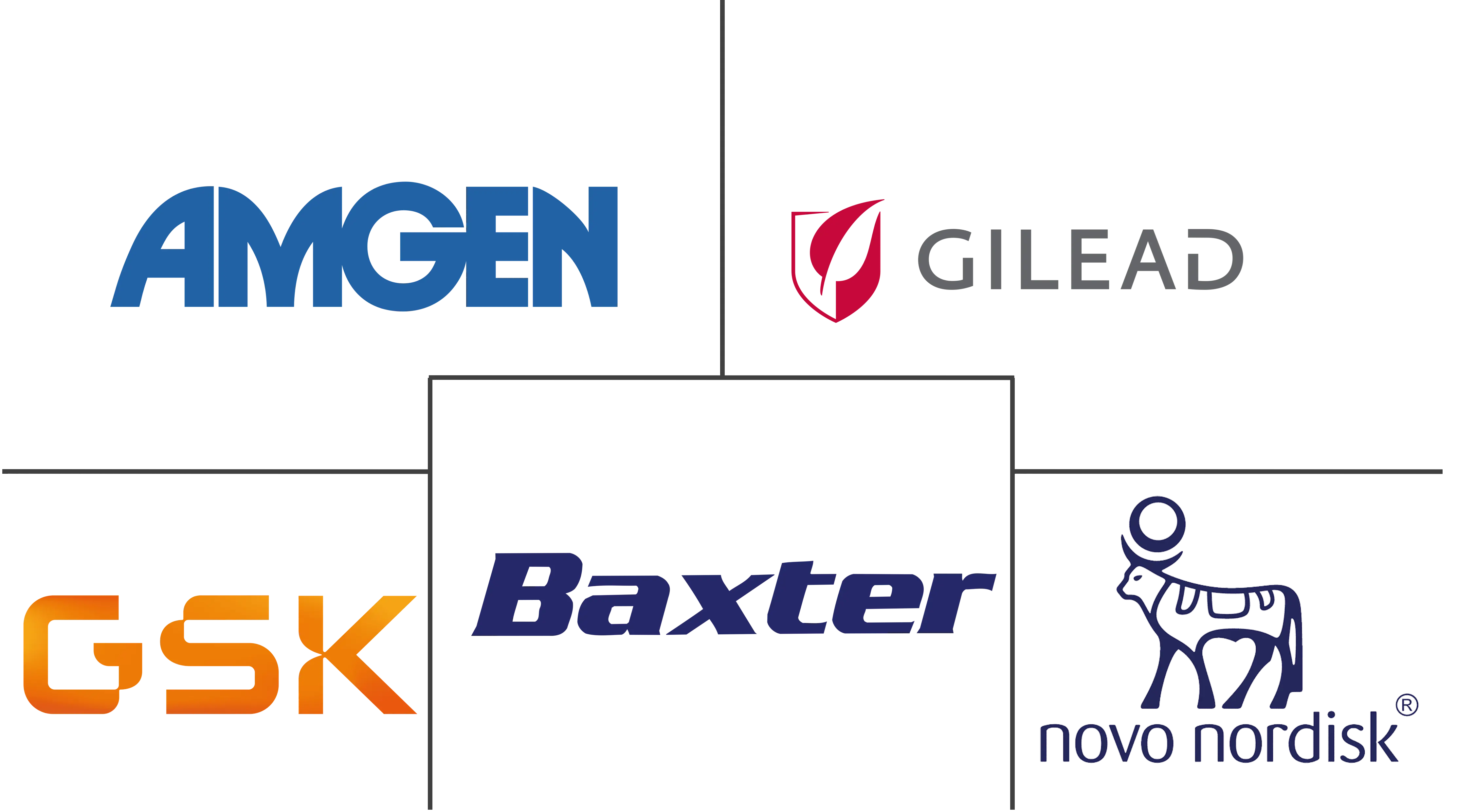
*Disclaimer: Major Players sorted in no particular order |
Injectable Drugs Market Analysis
The Injectable Drugs Market size is estimated at USD 569.89 billion in 2024, and is expected to reach USD 820.05 billion by 2029, growing at a CAGR of 7.55% during the forecast period (2024-2029).
Megatrends Driving Market Growth: The injectable drugs market is undergoing substantial growth, driven by key megatrends. Chronic disease prevalence is rising globally, necessitating more effective, targeted treatments that injectable drugs can offer. Biotechnological advancements are further supporting the development of sophisticated, potent injectable formulations. Additionally, the shift toward personalized medicine is increasing the demand for specialized injectable therapeutic solutions, allowing for patient-specific treatments.
Rising R&D Focus on Biotechnology-Engineered Anti-Cancer Drugs: A sharp focus on R&D in biotechnology-engineered injectable oncology drugs is evident within the biopharmaceutical industry. This is in response to the growing global cancer burden and the potential for these drugs to deliver more effective treatments. Collaborative efforts among pharmaceutical companies, academic institutions, and government agencies are leading to breakthroughs, particularly in injectable biologics for cancer therapy. These injectable formulations offer targeted drug delivery, improving treatment outcomes.
Rapid Growth in Pre-filled Syringes for Biologics: Pre-filled syringes are becoming the preferred delivery system for injectable biologics due to their ease of use, increased dose accuracy, and lower risk of contamination. The rising adoption of self-injecting drug delivery systems is contributing to the growth of this segment. Pre-filled syringes, particularly for complex biologics, are addressing challenges related to drug stability and ease of administration, thus enhancing injectable drugs market growth.
Increased Outsourcing Across the Value Chain: Outsourcing in the injectable drugs manufacturing process is growing, with pharmaceutical companies increasingly relying on contract research organizations (CROs) and logistics providers. This trend enhances production efficiency and allows companies to focus on core operations while scaling the supply of injectable pharmaceuticals. The strategy is especially pronounced in emerging markets with cost-efficient skilled labor, facilitating the more rapid distribution of injectable drugs worldwide.
Injectable Drugs Market Trends
Large Molecule Segment Dominates the Injectable Drugs Market
Segment Overview: The large molecule category dominates the injectable drugs landscape, comprising biologics like monoclonal antibodies and peptide hormones. These complex molecules offer high specificity and efficacy, particularly in the treatment of chronic and life-threatening diseases. By 2023, the large molecule segment controlled about 74% of the injectable drugs market share, underscoring its significant presence.
Growth Drivers: The expansion of the injectable drugs market size is being driven by several factors. The increasing global burden of chronic diseases and the corresponding rise in demand for targeted therapies are major catalysts. Advances in biotechnology and protein engineering have broadened the therapeutic applications of large molecules, fueling growth. Additionally, the increasing focus on orphan drugs and personalized treatments is bolstering the demand for biologics. This segment's future growth trajectory is underpinned by a strong pipeline of innovative biologics and sustained investments in biopharmaceutical R&D.
Competitive Strategies: To thrive in the competitive injectable drugs market, leading players are adopting a multi-pronged approach. Heavy investments in R&D, particularly for biologics, are critical to maintain market leadership. Companies are also forming strategic partnerships with biotechnology firms to drive innovation in injectable drug delivery systems. Expanding biologics manufacturing capabilities is another key strategy, ensuring quality and supply consistency. However, emerging challenges such as the rise of injectable biosimilars and advances in gene therapies may disrupt the competitive landscape, requiring vigilant strategic planning.
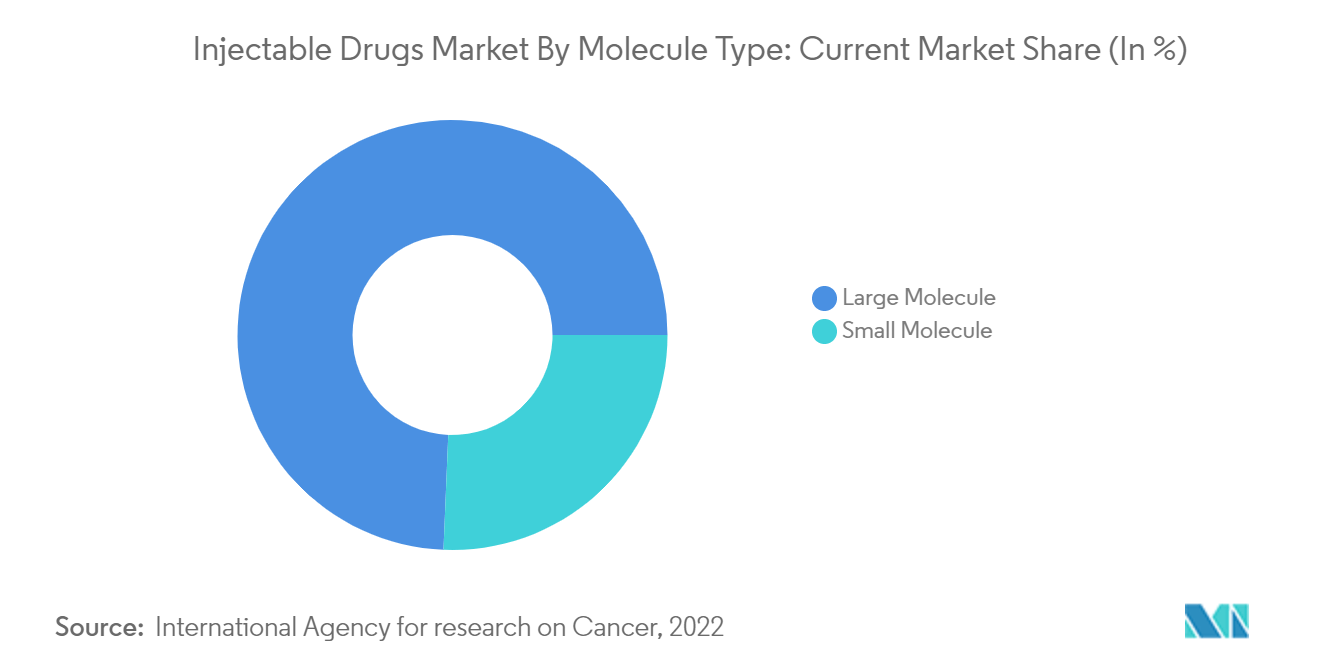
Asia-Pacific: The Fastest-Growing Regional Segment in Injectable Drugs Market
Regional Dynamics: The Asia-Pacific injectable drugs market is projected to outpace other regions, with a forecasted annual growth rate of 8.7% between 2024 and 2029. This growth is being driven by a confluence of factors, including rising healthcare expenditures, enhanced access to advanced therapies, and a large patient population with unmet medical needs.
Market Drivers: The expansion of the Asia-Pacific region is underpinned by increasing demand for injectable drugs as healthcare spending rises alongside growing disposable incomes. Governments in the region are enacting policies that boost domestic pharmaceutical production and attract foreign investment, contributing to the region's growing role in the injectable drug market. Additionally, the increasing prevalence of chronic diseases and a growing aging population are creating fertile ground for injectable therapies to thrive.
Strategic Imperatives: Companies aiming to capitalize on the rapid growth in Asia-Pacific are localizing injectable pharmaceuticals manufacturing and research facilities to cater to regional demand and meet regulatory requirements. Establishing partnerships with local healthcare providers and pharmaceutical firms will be crucial for successful market entry and distribution. Furthermore, price sensitivity in the region necessitates the development of affordable versions of injectable therapeutic solutions. Rapid adoption of biosimilars and local competition could present challenges, requiring companies to remain agile in their approach to this dynamic market.
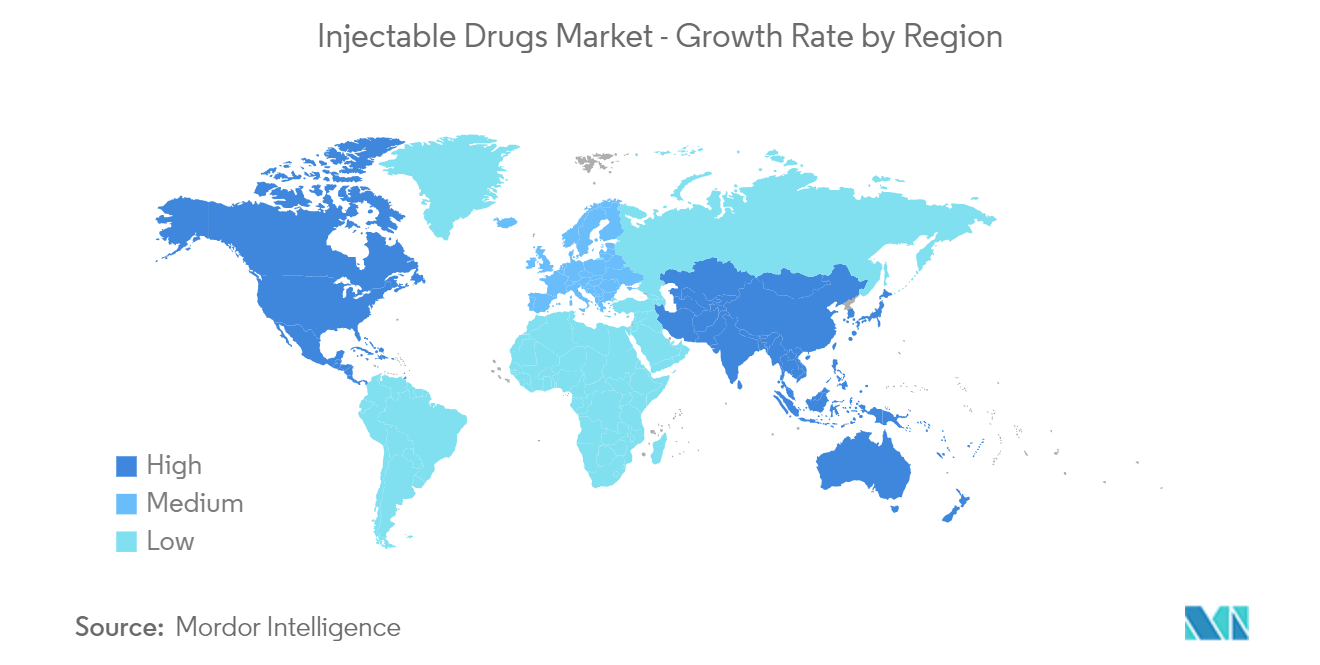
Injectable Drugs Industry Overview
Global Conglomerates Dominate Consolidated Market: The injectable drugs market is dominated by a handful of global pharmaceutical conglomerates, which control significant market share. High barriers to entry, such as capital-intensive injectable drug technologies and stringent regulatory requirements, contribute to this consolidation. Companies like Novo Nordisk, Amgen, Baxter International, and Pfizer lead the market, leveraging their extensive R&D capabilities, robust manufacturing infrastructure, and global distribution networks.
Market Leaders' Focus on Innovation and Scale: Leaders in the market are committed to continuous innovation in injectable formulations. For instance, Novo Nordisk’s innovative insulin products underscore its leadership in diabetes care. Amgen excels in biologic therapies for oncology, while Baxter focuses on hospital products and renal care solutions. Pfizer’s extensive therapeutic portfolio spans multiple areas, including injectable oncology drugs. These companies benefit from economies of scale, which enable competitive pricing and efficient global distribution.
Strategies for Future Success in the Market: To remain competitive, players are focusing on advanced drug delivery technologies, such as long-acting injectables and precision-targeted delivery systems, improving patient outcomes. Expanding biologics manufacturing capabilities and integrating Industry 4.0 technologies will be essential for enhancing production efficiency and quality control. Collaborations with biotechnology firms and academic institutions will fuel pipeline expansion. Additionally, tapping into emerging markets, particularly in Asia-Pacific and Latin America, where healthcare expenditures are increasing, offers significant growth potential.
Injectable Drugs Market Leaders
-
Novo Nordisk A/S
-
Amgen Inc.
-
Gilead Sciences Inc.
-
Baxter International
-
GSK plc
*Disclaimer: Major Players sorted in no particular order
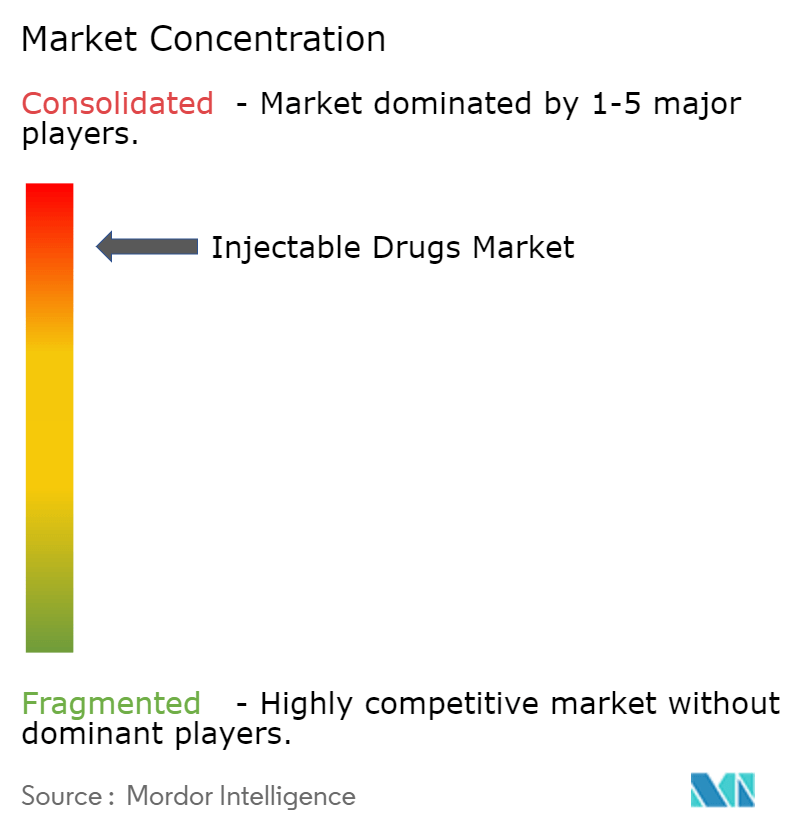
Injectable Drugs Market News
- May 2024: Sharp, a worldwide frontrunner in contract packaging, clinical supply services, and small-scale sterile manufacturing, has unveiled its intentions to expand its Macungie, Pennsylvania, facility in North America. This move aims to bolster the site's production capacity for the secondary packaging of sterile injectables. Macungie's expansion will boost its capacity for secondary packaging activities. These include vial labeling, assembly and labeling of pre-filled syringes (PFS), assembly and labeling of autoinjectors/pens, as well as kitting and cartoning of injectables, catering specifically to pharmaceutical and biotech firms.
- April 2024: Eli Lilly and Company entered into a definitive agreement with Nexus Pharmaceuticals, LLC, a prominent sterile manufacturer in the pharmaceutical sector, to acquire one of Nexus's manufacturing facilities. By acquiring this FDA-approved facility in Pleasant Prairie, Wisconsin, Lilly is set to bolster its global network for parenteral (injectable) product manufacturing, catering to the rising demand for its medicines. Lilly projects that production at this facility may commence by late 2025.
Injectable Drugs Market Report - Table of Contents
1. INTRODUCTION
- 1.1 Study Assumptions and Market Definition
- 1.2 Scope of the Study
2. RESEARCH METHODOLOGY
3. EXECUTIVE SUMMARY
4. MARKET DYNAMICS
- 4.1 Market Overview
-
4.2 Market Drivers
- 4.2.1 Rising R&D Focus on the Development of Biotechnology-engineered Anti-cancer Drugs
- 4.2.2 Rapid Growth in the Usage of Pre-filled Syringes for Biologics
- 4.2.3 Increased Outsourcing Activities Across Value Chain Expected to Boost Supply of Injectable Products
-
4.3 Market Restraints
- 4.3.1 High Expenses Associated with Inventory Management
- 4.3.2 Availability of Alternate Drug Delivery Methods
-
4.4 Porter's Five Forces Analysis
- 4.4.1 Threat of New Entrants
- 4.4.2 Bargaining Power of Buyers/Consumers
- 4.4.3 Bargaining Power of Suppliers
- 4.4.4 Threat of Substitute Products
- 4.4.5 Intensity of Competitive Rivalry
5. MARKET SEGMENTATION (Market Size by Value - USD)
-
5.1 By Molecule Type
- 5.1.1 Small Molecule
- 5.1.2 Large Molecule
-
5.2 By Drug Class
- 5.2.1 Blood Factors
- 5.2.2 Cytokines
- 5.2.3 Peptide Hormone
- 5.2.4 Immunoglobulin
- 5.2.5 Monoclonal Antibodies (mAbs)
- 5.2.6 Insulin
- 5.2.7 Other Drug Classes
-
5.3 By Application
- 5.3.1 Oncology
- 5.3.2 Neurology
- 5.3.3 Cardiovascular Diseases
- 5.3.4 Autoimmune Diseases
- 5.3.5 Infectious Diseases
- 5.3.6 Pain
- 5.3.7 Other Applications
-
5.4 By Geography
- 5.4.1 North America
- 5.4.1.1 United States
- 5.4.1.2 Canada
- 5.4.1.3 Mexico
- 5.4.2 Europe
- 5.4.2.1 Germany
- 5.4.2.2 United Kingdom
- 5.4.2.3 France
- 5.4.2.4 Italy
- 5.4.2.5 Spain
- 5.4.2.6 Rest of Europe
- 5.4.3 Asia-Pacific
- 5.4.3.1 China
- 5.4.3.2 Japan
- 5.4.3.3 India
- 5.4.3.4 Australia
- 5.4.3.5 South Korea
- 5.4.3.6 Rest of Asia-Pacific
- 5.4.4 Middle East and Africa
- 5.4.4.1 GCC
- 5.4.4.2 South Africa
- 5.4.4.3 Rest of Middle East and Africa
- 5.4.5 South America
- 5.4.5.1 Brazil
- 5.4.5.2 Argentina
- 5.4.5.3 Rest of South America
6. COMPETITIVE LANDSCAPE
-
6.1 Company Profiles
- 6.1.1 Novo Nordisk AS
- 6.1.2 Amgen Inc.
- 6.1.3 Baxter International Inc.
- 6.1.4 Gilead Sciences Inc.
- 6.1.5 GSK plc
- 6.1.6 Johnson & Johnson
- 6.1.7 Merck & Co. Inc.
- 6.1.8 Novartis AG
- 6.1.9 Pfizer Inc.
- 6.1.10 Sanofi SA
- 6.1.11 AbbVie
- 6.1.12 F. Hoffmann-La Roche Ltd
- *List Not Exhaustive
7. MARKET OPPORTUNITIES AND FUTURE TRENDS
** Subject To AvailablityInjectable Drugs Industry Segmentation
Injectable drugs are introduced into the body with a syringe and needle. These drugs are used to treat various diseases and disorders. The injectable drugs market is gaining importance in hospitals and clinics, with an increasing number of biologics, antibody-drug conjugates, monoclonal antibodies in development, and several injectable drugs under clinical trials globally.
The injectable drugs market is segmented by molecule type, drug class, application, and geography. By molecule type, the market is segmented into small molecules and large molecules. By drug class, the market is segmented into blood factors, cytokines, peptide hormones, immunoglobulin, monoclonal antibodies (mAbs), insulin, and other drug classes. By application, the market is segmented into oncology, neurology, cardiovascular diseases, autoimmune diseases, infectious diseases, pain, and other applications. By geography, the market is segmented into North America, Europe, Asia-Pacific, the Middle East and Africa, and South America. For each segment, the report offers market size and forecasts in terms of value (USD).
| By Molecule Type | Small Molecule | |
| Large Molecule | ||
| By Drug Class | Blood Factors | |
| Cytokines | ||
| Peptide Hormone | ||
| Immunoglobulin | ||
| Monoclonal Antibodies (mAbs) | ||
| Insulin | ||
| Other Drug Classes | ||
| By Application | Oncology | |
| Neurology | ||
| Cardiovascular Diseases | ||
| Autoimmune Diseases | ||
| Infectious Diseases | ||
| Pain | ||
| Other Applications | ||
| By Geography | North America | United States |
| Canada | ||
| Mexico | ||
| By Geography | Europe | Germany |
| United Kingdom | ||
| France | ||
| Italy | ||
| Spain | ||
| Rest of Europe | ||
| By Geography | Asia-Pacific | China |
| Japan | ||
| India | ||
| Australia | ||
| South Korea | ||
| Rest of Asia-Pacific | ||
| By Geography | Middle East and Africa | GCC |
| South Africa | ||
| Rest of Middle East and Africa | ||
| By Geography | South America | Brazil |
| Argentina | ||
| Rest of South America |
Injectable Drugs Market Research FAQs
How big is the Injectable Drugs Market?
The Injectable Drugs Market size is expected to reach USD 569.89 billion in 2024 and grow at a CAGR of 7.55% to reach USD 820.05 billion by 2029.
What is the current Injectable Drugs Market size?
In 2024, the Injectable Drugs Market size is expected to reach USD 569.89 billion.
Who are the key players in Injectable Drugs Market?
Novo Nordisk A/S, Amgen Inc., Gilead Sciences Inc., Baxter International and GSK plc are the major companies operating in the Injectable Drugs Market.
Which is the fastest growing region in Injectable Drugs Market?
Asia-Pacific is estimated to grow at the highest CAGR over the forecast period (2024-2029).
Which region has the biggest share in Injectable Drugs Market?
In 2024, the North America accounts for the largest market share in Injectable Drugs Market.
What years does this Injectable Drugs Market cover, and what was the market size in 2023?
In 2023, the Injectable Drugs Market size was estimated at USD 526.86 billion. The report covers the Injectable Drugs Market historical market size for years: 2019, 2020, 2021, 2022 and 2023. The report also forecasts the Injectable Drugs Market size for years: 2024, 2025, 2026, 2027, 2028 and 2029.
What are the major factors driving the Sterile Injectable Drugs Market?
The major factors driving the Sterile Injectable Drugs Market are a) Convenience and improved efficacy of injectable drugs b) Expanding healthcare infrastructure and access to injectable treatments
Injectable Drugs Industry Report
The global market for sterile injectable drugs is experiencing robust growth, driven primarily by the rising prevalence of chronic diseases and the increasing demand for effective treatment options. Significant advancements in drug formulations, especially for conditions like cancer, diabetes, and cardiovascular diseases, are fueling this expansion. Monoclonal antibodies, peptide hormones, and vaccines are amongst the key products enhancing market growth. Further propelled by significant investments in R&D, these innovations are improving the safety and efficacy of injectable drugs. Additionally, advances in manufacturing technologies are increasing the efficiency and cost-effectiveness of production processes. Regionally, North America leads due to its strong healthcare infrastructure and extensive R&D activities, followed closely by Europe and the rapidly growing Asia Pacific market. The stringent regulatory framework globally ensures the safety and efficacy of these drugs, boosting consumer confidence and contributing to market growth. For a deeper dive into the market, including statistics on market share, size, and growth predictions, a comprehensive analysis is available for free download from Mordor Intelligence™.



